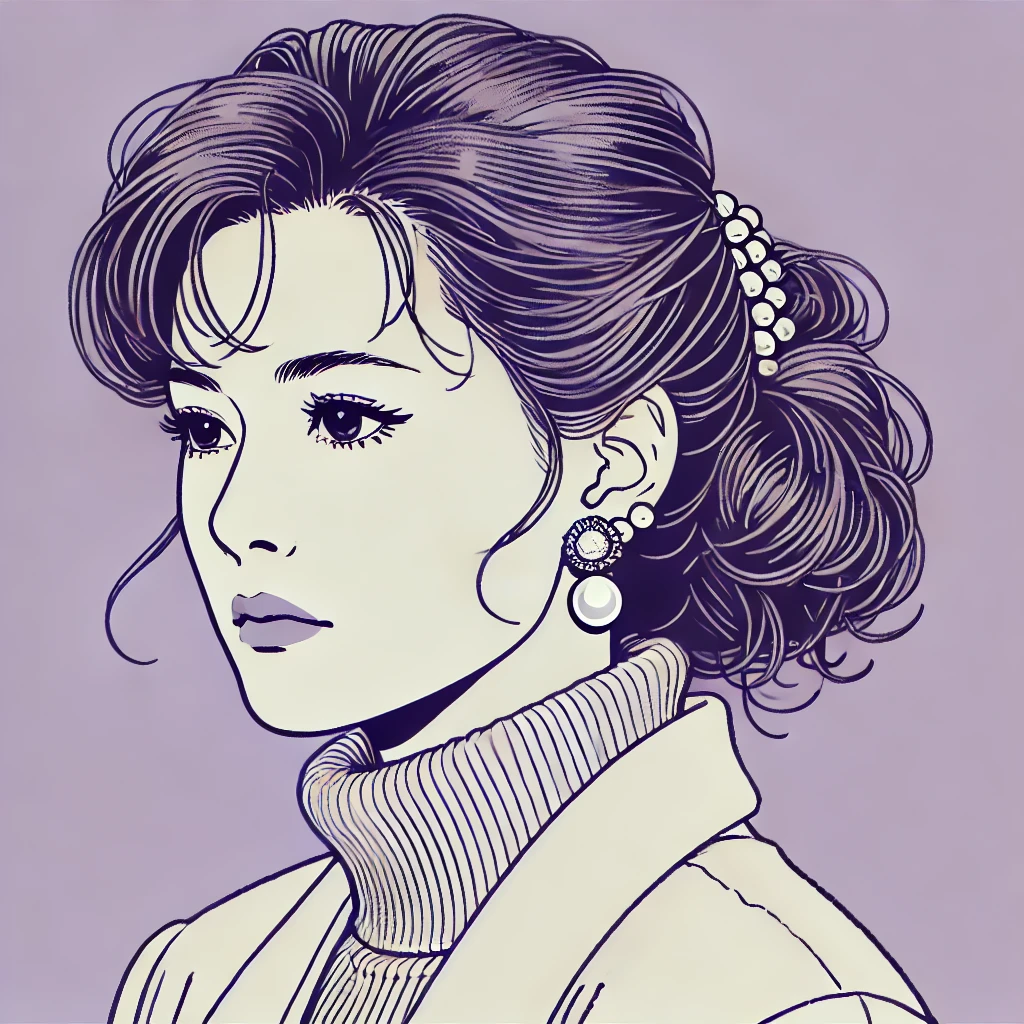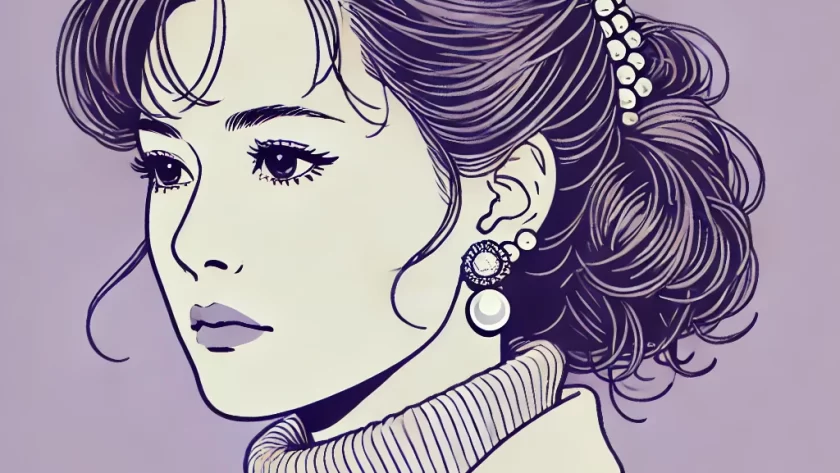飾りじゃないのよ涙は [Kazari Ja Nai No Yo Namida Wa]
中森明菜 [NAKAMORI Akina]
Words & Music : 井上陽水 [INOUE Yōsui]
Akina Nakamori is an idol from the same generation as Seiko Matsuda, whom I introduced yesterday. Nakamori and Matsuda are often seen as rivals, representing the top two idols of the 1980s. While Seiko Matsuda was promoted with a girlish image, Akina Nakamori was marketed with a more rebellious persona.
Nakamori appeared on the TV audition show “Sutā Tanjō!” and received a “pass” after singing a Momoe Yamaguchi song. She debuted in 1982 and produced several hit songs.
Released in 1984, “Kazari ja Nai no yo Namida wa” was Nakamori’s 10th single, a song provided by Yōsui Inoue. It is said that this song marked a turning point in her career from being an idol to becoming a singer and musician. Let’s take a look at the lyrics of this song.
私は泣いたことがない
watashi wa naita koto ga nai
灯の消えた街角で
akari no kieta machikado de
速い車にのっけられても
hayai kuruma ni nokkerarete mo
急にスピンかけられても 恐くなかった
kyū ni supin kakerarete mo kowaku nakatta
- 私(わたし) [watashi] : I
- 泣く(なく) [naku] : cry
- 灯(あかり) [akari] : light
- 消える(きえる) [kieru] : go out, disappear
- 街角(まちかど) [machikado] : street corner
- 速い(はやい) [hayai] : fast
- 車(くるま) [kuruma] : car
- 乗っける(のっける) [nokkeru] : to give a ride, to put on
- 急に(きゅうに) [kyū ni] : suddenly
- スピン(すぴん) [supin] : spin
- 怖い(こわい) [kowai] : scary
(translation) “I have never cried
on the darkened street corner.
Even when I was given a ride in a fast car,
even when it suddenly spun, I wasn’t scared.”
The phrase “…たことがある(ない) / …takoto ga aru (nai)” means “to have (not) done …”
“乗っける / nokkeru” is a casual way of saying “乗せる / noseru,” which means “to give a ride.”

赤いスカーフがゆれるのを 不思議な気持ちで見てたけど
akai sukāfu ga yureru no o fushigi na kimochi de miteta kedo
私泣いたりするのは 違うと感じてた
watashi naitari suru no wa chigau to kanjitetta
- 赤い(あかい) [akai] : red
- スカーフ(すかーふ) [sukāfu] : scarf
- 揺れる(ゆれる) [yureru] : sway
- 不思議な(ふしぎな) [fushigi na] : strange, mysterious
- 気持ち(きもち) [kimochi] : feeling
- 見ている(みている) [miteiru] : watching
- 違う(ちがう) [chigau] : different, wrong
- 感じる(かんじる) [kanjiru] : feel
(translation) “I watched the red scarf sway
with a strange feeling, but
I felt that crying wasn’t right.”
This use of “違う / chigau” feels a bit colloquial and modern, even as of 2024. Here, it implies a sense of “wrongness.” It’s a line that suggests the speaker believes crying would go against some unspoken rule.
私は泣いたことがない
watashi wa naita koto ga nai
つめたい夜の真ん中で
tsumetai yoru no mannaka de
いろんな人と すれ違ったり
ironna hito to surechigattari
投げ Kiss 受けとめたり 投げ返したり
nage Kiss uketometari nagekaeshitari
- 冷たい(つめたい) [tsumetai] : cold
- 夜(よる) [yoru] : night
- 真ん中(まんなか) [mannaka] : middle
- いろんな [ironna] : various
- 人(ひと) [hito] : people
- すれ違う(すれちがう) [surechigau] : to pass by, to cross paths
- 投げキッス(なげきっす) [nage Kiss] : blown kiss
- 投げる(なげる) [nageru] : to throw
- 受け止める(うけとめる) [uketomeru] : to catch, to receive
- 返す(かえす) [kaesu] : to return
(translation) “I have never cried
in the middle of a cold night.
I passed by various people,
caught blown kisses, and returned them.”
そして友達が変わるたび 想い出ばかりがふえたけど
soshite tomodachi ga kawaru tabi omoide bakari ga fueta kedo
私 泣いたりするのは 違うと感じてた
watashi naitari suru no wa chigau to kanjitetta
- そして [soshite] : and then
- 友達(ともだち) [tomodachi] : friend
- 変わる(かわる) [kawaru] : change
- 思い出(おもいで) [omoide] : memory
- 増える(ふえる) [fueru] : increase
(translation) “And then, as friends changed, only memories increased, but
I felt that crying wasn’t right.”
飾りじゃないのよ涙は HA HAN
kazari ja nai no yo namida wa
好きだと言ってるじゃないの HO HO
suki da to itteru ja nai no
真珠じゃないのよ涙は HA HAN
shinju ja nai no yo namida wa
きれいなだけならいいけど
kirei na dake nara ii kedo
ちょっと悲しすぎるのよ涙は HO HO HO…
chotto kanashi sugiru no yo namida wa
- 飾り(かざり) [kazari] : decoration
- 涙(なみだ) [namida] : tear
- 好きだ(すきだ) [suki da] : like, love
- 言う(いう) [iu] : say
- 真珠(しんじゅ) [shinju] : pearl
- 綺麗な(きれいな) [kirei na] : beautiful, clean
- だけ [dake] : only, just
- いい [ii] : good
- ちょっと [chotto] : a little
- 悲しい(かなしい) [kanashii] : sad
- ..すぎる [..sugiru] : too much, overly
(translation) “Tears aren’t just a decoration.
I’m telling you I love you.
Tears aren’t just pearls.
It’s fine if they’re just beautiful, but
they’re a little too sad”
I need to provide some grammatical explanations. The first line of the block, which is also the title, uses inversion, placing the subject (“涙は / namida wa”) at the very end. “じゃない / ja nai” is a casual way of saying “ではない / dewa nai” (= is not) which we encountered yesterday as well. Therefore, “飾りじゃないのよ涙は / kazari ja nai no yo namida wa” means “Tears aren’t just a decoration.”
Next, the “じゃない / ja nai” in the second line is rhetorical, and in principle, it functions here as “好きだと言っている / suki da to itteiru” (=I say I like you) followed by “じゃない / ja nai” (=Don’t I?). It serves as an emphasis, and unlike in the first line, it does not carry a negative meaning.
The usage in the third line is the same as in the first line. Both usages are common in conversation.

私は泣いたことがない
watashi wa naita koto ga nai
本当の恋をしていない
honto no koi o shite inai
誰の前でもひとりきりでも
dare no mae demo hitorikiri demo
瞳の奥の涙は 隠していたから
hitomi no oku no namida wa kakushite ita kara
- 本当(ほんとう) [hontō] : true, real
- 誰の(だれの) [dare no] : whose
- 前(まえ) [mae] : in front of, before
- ひとりきり [hitorikiri] : all alone
- 瞳(ひとみ) [hitomi] : eyes, pupils
- 奥(おく) [oku] : depths, inner
- 隠す(かくす) [kakusu] : hide
(translation) “I have never cried
I haven’t experienced true love
Even in front of others or when alone
Because I have hidden the tears in the depths of my eyes.”
いつか恋人に会える時
itsuka koibito ni aeru toki
私の世界が変わる時
watashi no sekai ga kawaru toki
私 泣いたりするんじゃないかと感じてる
watashi naitari surun janai ka to kanjiteru
きっと泣いたりするんじゃないかと感じてる
kitto naitari surun janai ka to kanjiteru
- いつか [itsuka] : someday
- 恋人(こいびと) [koibito] : lover
- 会う(あう) [au] : meet
- 時(とき) [toki] : time
- 世界(せかい) [sekai] : world
- 変わる(かわる) [kawaru] : change
(translation) “When I can someday meet my lover
When my world changes
I feel like I might cry
I’m sure I’ll end up crying.”
The “じゃない / ja nai” in the third and fourth lines of this block is closer to rhetorical usage rather than a negative one. Since the question-forming “か / ka” is included, it should be translated in a way that captures the ambiguity.

飾りじゃないのよ涙は HA HAN
kazari ja nai no yo namida wa
好きだと言ってるじゃないの HO HO
suki da to itteru ja nai no
真珠じゃないのよ涙は HA HAN
shinju ja nai no yo namida wa
きれいなだけならいいけど
kirei na dake nara ii kedo
ちょっと悲しすぎるのよ涙は
chotto kanashi sugiru no yo namida wa
飾りじゃないのよ涙は HA HAN
kazari ja nai no yo namida wa
かがやくだけならいいけど HO HO
kagayaku dake nara ii kedo
ダイヤと違うの涙は HA HAN
daiya to chigau no namida wa
さみしいだけならいいけど
samishii dake nara ii kedo
ちょっと悲しすぎるのよ涙は
chotto kanashi sugiru no yo namida wa
- 輝く(かがやく) [kagayaku] : shine
- ダイヤ (だいや)[daiya] : diamond
- 違う(ちがう) [chigau] : different
- 寂しい(さびしい) [sabishii] : lonely
(translation) “Tears aren’t just a decoration
It’s fine if they just shine
Tears aren’t the same as diamonds
It’s fine if they’re just lonely
But tears are a bit too sad.”
These lyrics are incredibly cool, aren’t they?
I apologize for the extensive grammatical explanations. I didn’t expect so much “じゃない / ja nai” to appear, but I think it ’s good for learning.
Yōsui Inoue, who provided this song, also released a self-cover version the same year. The lyrics use the first-person pronoun “私 / watashi,” which is typically used by women, and there are some feminine expressions. Therefore, it felt a bit strange to hear Yōsui Inoue singing it. However, as lyrics have become more “diverse” in recent years, this doesn’t seem unusual anymore. The arrangement for Yōsui Inoue’s version was done by Joe Hisaishi, who was still relatively unknown at the time.
Thanks for reading! Feel free to comment if you have any feedback or questions.
Follow me on X.



